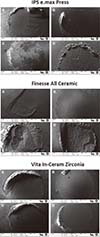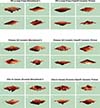1. Kon M, Kawano F, Asaoka K, Matsumoto N. Effect of leucite crystals on the strength of glassy porcelain. Dent Mater J. 1994; 13:138–147.
2. Seghi RR, Sorensen JA. Relative flexural strength of six new ceramic materials. Int J Prosthodont. 1995; 8:239–246.
3. Seghi RR, Denry IL, Rosenstiel SF. Relative fracture toughness and hardness of new dental ceramics. J Prosthet Dent. 1995; 74:145–150.
4. Denry IL, Mackert JR Jr, Holloway JA, Rosenstiel SF. Effect of cubic leucite stabilization on the flexural strength of feldspathic dental porcelain. J Dent Res. 1996; 75:1928–1935.
5. Mackert JR Jr, Russell CM. Leucite crystallization during processing of a heat-pressed dental ceramic. Int J Prosthodont. 1996; 9:261–265.
6. Piconi C, Maccauro G. Zirconia as a ceramic biomaterial. Biomaterials. 1999; 20:1–25.
7. Ozcan M, Vallittu PK. Effect of surface conditioning methods on the bond strength of luting cement to ceramics. Dent Mater. 2003; 19:725–731.
8. Della Bona A, Anusavice KJ. Microstructure, composition, and etching topography of dental ceramics. Int J Prosthodont. 2002; 15:159–167.
9. Matinlinna JP, Lassila LV, Ozcan M, Yli-Urpo A, Vallittu PK. An introduction to silanes and their clinical applications in dentistry. Int J Prosthodont. 2004; 17:155–164.
10. de Carvalho RF, Martins ME, de Queiroz JR, Leite FP, Ozcan M. Influence of silane heat treatment on bond strength of resin cement to a feldspathic ceramic. Dent Mater J. 2011; 30:392–397.
11. Chen JR, Oka K, Kawano T, Goto T, Ichikawa T. Carbon dioxide laser application enhances the effect of silane primer on the shear bond strength between porcelain and composite resin. Dent Mater J. 2010; 29:731–737.
12. Chung KH, Hwang YC. Bonding strengths of porcelain repair systems with various surface treatments. J Prosthet Dent. 1997; 78:267–274.
13. Suliman AH, Swift EJ Jr, Perdigao J. Effects of surface treatment and bonding agents on bond strength of composite resin to porcelain. J Prosthet Dent. 1993; 70:118–120.
14. Cotes C, de Carvalho RF, Kimpara ET, Leite FP, Ozcan M. Can heat treatment procedures of pre-hydrolyzed silane replace hydrofluoric acid in the adhesion of resin cement to feldspathic ceramic? J Adhes Dent. 2013; 15:569–574.
15. Fabianelli A, Pollington S, Papacchini F, Goracci C, Cantoro A, Ferrari M, van Noort R. The effect of different surface treatments on bond strength between leucite reinforced feldspathic ceramic and composite resin. J Dent. 2010; 38:39–43.
16. Bertolini JC. Hydrofluoric acid: a review of toxicity. J Emerg Med. 1992; 10:163–168.
17. Monticelli F, Toledano M, Osorio R, Ferrari M. Effect of temperature on the silane coupling agents when bonding core resin to quartz fiber posts. Dent Mater. 2006; 22:1024–1028.
18. Shimada Y, Yamaguchi S, Tagami J. Micro-shear bond strength of dual-cured resin cement to glass ceramics. Dent Mater. 2002; 18:380–388.
19. Hooshmand T, van Noort R, Keshvad A. Bond durability of the resin-bonded and silane treated ceramic surface. Dent Mater. 2002; 18:179–188.
20. Filho AM, Vieira LC, Araújo E, Monteiro Júnior S. Effect of different ceramic surface treatments on resin microtensile bond strength. J Prosthodont. 2004; 13:28–35.
21. Krämer N, Lohbauer U, Frankenberger R. Adhesive luting of indirect restorations. Am J Dent. 2000; 13:60D–76D.
22. Edelhoff D, Ozcan M. To what extent does the longevity of fixed dental prostheses depend on the function of the cement? Working Group 4 materials: cementation. Clin Oral Implants Res. 2007; 18:193–204.
23. Roulet JF, Söderholm KJ, Longmate J. Effects of treatment and storage conditions on ceramic/composite bond strength. J Dent Res. 1995; 74:381–387.
24. Kelly JR, Campbell SD, Bowen HK. Fracture-surface analysis of dental ceramics. J Prosthet Dent. 1989; 62:536–541.
25. Rosenstiel SF, Land MF, Crispin BJ. Dental luting agents: A review of the current literature. J Prosthet Dent. 1998; 80:280–301.
26. Al-Dohan HM, Yaman P, Dennison JB, Razzoog ME, Lang BR. Shear strength of core-veneer interface in bi-layered ceramics. J Prosthet Dent. 2004; 91:349–355.
27. Craig RG JP. Restorative dental materials. Mosby;2002. p. 85.
28. Choi BK, Han JS, Yang JH, Lee JB, Kim SH. Shear bond strength of veneering porcelain to zirconia and metal cores. J Adv Prosthodont. 2009; 1:129–135.
29. de Carvalho RF, Cotes C, Kimpara ET, Leite FP, özcan M. Heat treatment of pre-hydrolyzed silane increases adhesion of phosphate monomer-based resin cement to glass ceramic. Braz Dent J. 2015; 26:44–49.
30. Moharamzadeh K, Hooshmand T, Keshvad A, Van Noort R. Fracture toughness of a ceramic-resin interface. Dent Mater. 2008; 24:172–177.
31. al Edris A, al Jabr A, Cooley RL, Barghi N. SEM evaluation of etch patterns by three etchants on three porcelains. J Prosthet Dent. 1990; 64:734–739.
32. Corazza PH, Cavalcanti SC, Queiroz JR, Bottino MA, Valandro LF. Effect of post-silanization heat treatments of silanized feldspathic ceramic on adhesion to resin cement. J Adhes Dent. 2013; 15:473–479.
33. Blatz MB, Sadan A, Blatz U. The effect of silica coating on the resin bond to the intaglio surface of Procera AllCeram restorations. Quintessence Int. 2003; 34:542–547.
34. Blatz MB, Sadan A, Kern M. Resin-ceramic bonding: a review of the literature. J Prosthet Dent. 2003; 89:268–274.
35. Barghi N. To silanate or not to silanate: making a clinical decision. Compend Contin Educ Dent. 2000; 21:659–662. 664quiz 666.
36. Söderholm KJ, Shang SW. Molecular orientation of silane at the surface of colloidal silica. J Dent Res. 1993; 72:1050–1054.
37. Yoshida K, Kamada K, Atsuta M. Effects of two silane coupling agents, a bonding agent, and thermal cycling on the bond strength of a CAD/CAM composite material cemented with two resin luting agents. J Prosthet Dent. 2001; 85:184–189.
38. Lu YC, Tseng H, Shih YH, Lee SY. Effects of surface treatments on bond strength of glass-infiltrated ceramic. J Oral Rehabil. 2001; 28:805–813.
39. Yavuz T, Dilber E, Kara HB, Tuncdemir AR, Ozturk AN. Effects of different surface treatments on shear bond strength in two different ceramic systems. Lasers Med Sci. 2013; 28:1233–1239.
40. Kansu G, Gökdeniz B. Effects of different surface treatment methods on the bond strengths of resin cements to full ceramic systems. J Dent Sci. 2011; 6:134–139.




 PDF
PDF ePub
ePub Citation
Citation Print
Print











 XML Download
XML Download